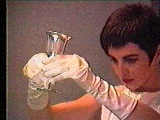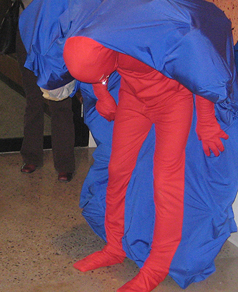 Introduction by Cliff Eyland Essay on Kubrick's The Shining by Stephen Snyder Essay by John Massier Essay by Milena Placentile REDRUM poster (2 MB PDF) Back to first Jillian Mcdonald page 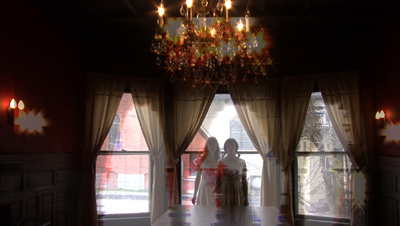 Above: a still from Jillian Mcdonald's Redrum video, 2010. HERE'S JILLIAN! by Cliff Eyland Redrum was created by Jillian Mcdonald in residence at Hallwalls Contemporary Arts Center, and was filmed on location in Buffalo, NY homes in late 2009. It includes local teenagers as the cast and crew, and a soundtrack recorded in collaboration with The Buffalo Soundpainting Ensemble. It is a high definition video, 7:44 minutes long, dated 2010. As Mcdonald puts it [in a statement from her website that I have edited] as a way of explaining Redrum's allusions to Stanley Kubrick's movie The Shining: "...a boy predicts 'redrum' (murder) before a hotel elevator bursts with blood and all hell breaks loose. This video has a haunted horror theme. The scenes take us through a cavernous home where blood -- a predominant prop in horror films -- drips from faucets, runs down mirrors, and pools on stairs. The blood appears disembodied until the camera slowly reveals its haunted source, visiting neighbouring houses that also drip with blood, suggesting a murderous streak." Reconnecting Jillian McDonald's Redrum to Winnipeg's dark side may be as easy as suggesting that the Overlook Hotel in Stanley Kubrick's The Shining is a perfect metaphor for Mcdonald's home town Winnipeg. Kubrick/Stephen King's story about the young family contracted to take care of an isolated hotel during a particularly nasty winter writes the very circumstances of Winnipeg gothic large. As Stephen Snyder puts it in his 1982 essay, reproduced on this website: If Kubrick's America is a land of inner oriented retreaters, it is also a land of suppressed violence which lingers into the present, like the smoke of the burnt toast in the story which Hallrun offers to Danny as an explicatory analogy to the operation of ghosts. This violence is associated with the history of American conquest quite early in the film, when we learn from Ullman -- in the midst of the follow-the-leader tour -- that the resort has been built on an Indian burial ground. The foundation of the resort rests upon the conquest by a "civilized" group of people over a more primitive tribe. However, the condition of conquest has resulted not in the acquisition of one tribe's consciousness by the other but the complete fracturing of the two. In one sense civilization built on the death of a primitive consciousness is a society split from nature and its organic energies, its source. In America at least, native myths, as Ruth Benedict argues, had a holistic, "animate" view of nature and of the human's place in it. Kubrick employs this sense of division metaphorically, as the rationalists in his film want to place themselves above that which they see as primitive. -- an excerpt from an essay on Kubrick's The Shining by Stephen Snyder 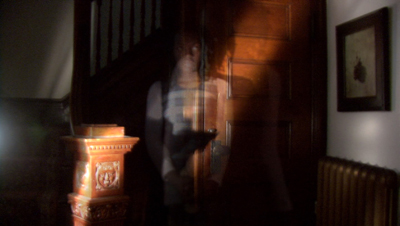 Above: a still from Jillian Mcdonald's Redrum video, 2010. John Massier also contributes a beautiful piece of writing to our website about Redrum that originally appeared in a Hallwalls brochure: Perhaps the most startling aspect of Jillian Mcdonald's new piece, Redrum, is not that it is a genre examination, or that it investigates familiar tropes of that genre, or layers a critical perspective upon these familiar, time-worn tropes -- it does all these things. But in doing all the things we expect art to do, critically, it's also just scary. Even though we know the devices being used, even though we know it's an artistic treatment of a popular form, even though the manipulation of image and sound is overt and direct, even though we may believe ourselves too savvy or jaded to buy into the manipulation -- despite our awareness of all these aspects, Redrum contains genuine jolts, haunting atmosphere, and a believable sense of doom.Jillian Mcdonald has lived in New York for many years, but she's from Winnipeg, and she established herself as a young artist even before leaving for Hunter College graduate school in 1996. She was awarded arts grants right after finishing her University of Manitoba BFA studies in 1993, and importantly, in 1998 her work was included in an exhibition at Winnipeg's Plug In Gallery called Draaw Stranger Draaw, curated by Wayne Baerwaldt. "Winnipeg gothic" is part of a much wider gothic-influenced scene, and it shares Romantic, Freudian, and popular horror film and fiction influences with a much wider world of art. Mcdonald is a kind of goth artist, but when we reconnect her work to Winnipeg, we know that it could just as easily be linked to Belgian or Sri Lankan contemporary art, or a hundred other art contexts. When I cite, for example, David McMillan's Chernobyl photographs, Sharon Alward's videos and performances, Guy Maddin's films, and Ivan Eyre and Esther Warkov's post-surrealist painting as possible influences on Mcdonald, I don't mean to discount the influence of the wider gothic -- especially 1990s -- scene. (Please see, as a good overview, the book/exhibition catalogue Gothic: Transmutations of Horror in Late Twentieth Century Art, edited by Christoph Grunenberg, Cambridge: The Insititute of Contemporary Art/The MIT Press, 1997.) This thinking also applies to a host of Winnipeg artists Mcdonald's age and younger who engage gothic themes, including Diana Thorneycroft, Sarah Anne Johnson, Krisjanis Kaktins Gorsline, and many others. 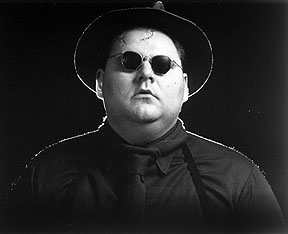
|
